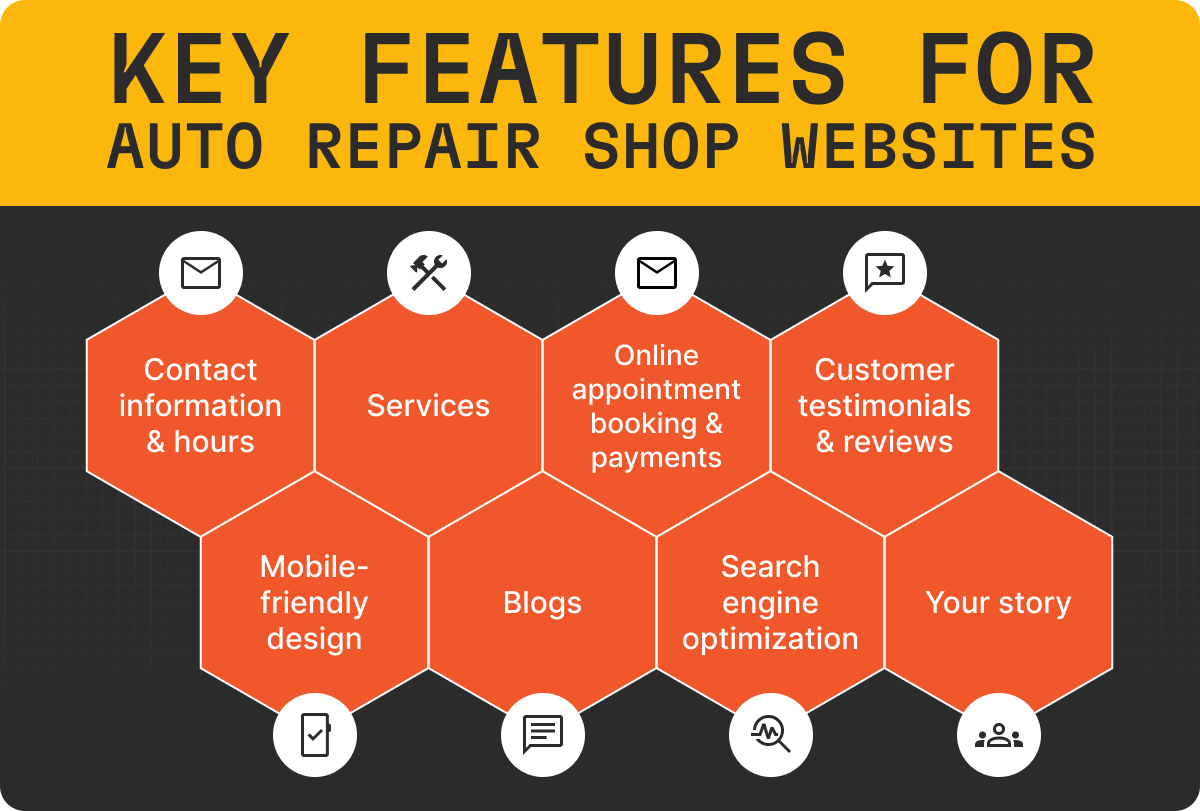How Saying “Yes” Grows Business
According to Hubspot Research, 93% of customers are more likely to return to companies that offer excellent customer service. Let’s look at a pretty common scenario: a customer’s car breaks down just as they're headed to work, or their one mode of transportation that gets them to and from their kid’s school isn’t starting. If they walk into your shop, chances are a quick and easy fix is all they’re hoping to find. Ideally they would schedule an appointment in advance, but life doesn’t always work out that way.
The ability to say “yes” to your customers when they bring their car in, or phone the shop, is ideal. Practicing a “yes” mindset means accepting the reality that many drivers don’t have time to schedule repairs in advance, and finding a solution to help each and every guest. Inversely, if you're turning customers away, that leads to more idle time and lost revenue.
Although a, “Yes, we’ll take care of it right away” isn’t always possible due to additional work going on, it’s still comforting for driver’s to receive a simple, “We’ll get it on the calendar.” And once the customer receives the appointment confirmation on their end, they’ll be able to set that worry aside, and focus on the rest of their day.
If your shop doesn’t have the ability to say yes to every viable customer, chances are there isn’t a scheduling software in place that allows your service advisor to check into the day, week, or even month’s tasks.
Automotive scheduling software helps your team prioritize their RO’s in such a way that allows for additional walk-ins.
Benefits of Automotive Scheduling Software
The benefits of automotive scheduling software fall under three categories: service, efficiency, and focus. Tending to each of these categories is crucial in any business, especially in the auto repair industry. Automotive scheduling software will enhance your team’s ability to control the flow of work at the shop and maximize efficiency.
Rather than spending your days at the shop wondering what’s going on with so and so’s vehicle, you can simply check the status of their car under the schedule. Because automotive scheduling software enhances the service, efficiency, and focus of your shop, it will provide a shorter turnaround span on ROs. And the less amount of time it takes for your team to work on getting a car in and out, the more time you can focus on maintaining and fostering customer loyalty.
1. An Improved Customer Service Experience
First impressions have a major impact in this industry. According to the J.D. Power 2021 U.S. Aftermarket Service Index (ASI) Study, customer satisfaction is heavily dependent on quality work done promptly, explained clearly, for a fair price, and delivered with excellent customer service.
The study involved 8,148 vehicle owners and was conducted between July and October of 2020. A key finding in this study was that, “Among customers who said they waited three minutes or more—which ranged from 27% to 39%—satisfaction scores declined as much as 219 points.”
Automotive scheduling software grants service advisors the ability to quickly greet customers thanks to its easy navigation system. Rather than spending time trying to find the right button or detail, service advisors should feel like they have a clear picture of what each day entails in your shop: which technician is at each car, the parts that are ordered for ROs or canned jobs, and, of course, which customer is returning or stepping foot in your shop for the first time.
2. A Smooth Start Leads to an Efficient Repair Process
Starting off on the right foot will greatly impact the rest of the repair process. Our motto here is less chaos, more structure. Automotive scheduling software helps your team focus on efficiency and consistency.
Having an organized, user-friendly scheduling system for your shop takes away risks such as double-booking. The system you choose for your shop will show each customer, each repair—whether that be a simple oil change or something more complicated like replacing a transmission—as you book it and when you book it, which not only saves your service advisors time, but also saves them from facing frustrated customers that have been unknowingly double-booked.
Along those lines, the ability to sync your software’s calendar on any smart device allows you to maintain your shop’s workflow while away, and also provides your service advisors peace of mind if they ever need to step away from the front desk.
3. Focus on the Cars; Let the Calendar do the Scheduling
Carefully selecting the right scheduling system and software for your shop will allow your technicians to focus on the cars, rather than spending additional time writing down the ROs. Entering ROs, Digital Vehicle Inspections (DVIs), customer notes, and running the CARFAX report can all be done within minutes using the same auto repair scheduling software.
Gaining this extra time will provide peace of mind to every team member; they’ll know where they need to be, and what RO they’re assigned to, as well as any upcoming repairs. Optimizing your staff’s productivity means improving your shop’s average repair orders (AROs) and making room for new customers.
Features to Look For in Automotive Scheduling Software
A big part of transforming your shop is not only finding the right team and location but also finding the right scheduling strategies and systems that keep your shop afloat and your team sane. Automotive scheduling software can have different approaches to service, efficiency, and focus depending on which program you decide to go with.
Many modern day shops, whether independently owned or part of a chain, will be “shopping” for the same set of features that will significantly improve their shop’s environment. This includes, but is not limited to, an intuitive user experience, an easy way to set/adjust/automate appointments, and that each appointment has all necessary information presented, including vehicle, customer information, declined jobs, and customer history.
Here are five questions shop owners can ask themselves when searching for the right auto repair scheduling software:
- Is it cloud-based?
- Does it tie into other systems? (What integrations does it have?)
- Does it offer streamlined customer communication tools?
- Does it offer trackable auto repair notes, customer notes, etc.?
- Can I easily migrate data?
1. Intuitive User Experience
What features do you look for when using digital platforms such as your phone or computer calendar? Whether for personal planning or work tasks, the fewer tabs to navigate through or buttons to click, the better. The quicker you can schedule an appointment, the faster you can move on.
This holds true for your shop’s scheduling software. If it’s easy to train your service advisors to use, and your technicians are able to find the RO’s that are assigned to them, then you can ensure everyone will be on the same page—or in this case, interface.
Additionally, if the scheduling software you choose has a calendar feature, it will give your team the ability to color code their calendars to their liking. Whether you color code for technicians, the type of work, or type of appointment is completely up to you.
A scheduling software worth its salt will also give your shop the ability to view the agenda for the day, the workweek, or a month overview. You’ll be able to see exactly what’s going on in your shop and when.
2. Set and Adjust Appointments
The perks of scheduling software is that you can create appointments for customers with minimal information; all you need is a name and a phone number to reserve their appointment time.
Only gathering the most important information at first prevents your team from being held back from entering a ton of information when they could be simply focusing on their customer and their vehicle. You can always gather any additional information later on when you’re checking out the customer.
3. Customer Notes
The ability to easily create and access customer profile pages will strengthen the relationship between your service writers and customers.
Look for a scheduling software with customer pages that quickly and easily display pertinent information about the vehicle and its service history, which allows service advisors to quickly determine what work needs to be done, and in turn, ensures that the processes of intaking and assigning work are done faster.
An efficient customer notes interface should lead to fewer wasted minutes, more captured revenue, and more loyal customers.
4. Digital Vehicle Inspections (DVIs)
Along with easily accessing notes about your customer, you should also be able pull up any previous DVI’s for any specific customer. The benefit of conducting a DVI each time a customer visits the shop is that it paints a clear picture of what exactly is going on with their vehicle. For example, if their car’s brake fluid was marked as yellow (may require attention soon), the technician will know to check it during the customer’s next visit.
5. Integrations
Modern shop management software should integrate with additional industry-leading resources so that shops can function as smoothly as possible. It is likely that your shop already has digital tools in place that you’ve become acquainted with, like CARFAX vehicle history reports, for example. If that’s the case, look for an automotive scheduling software that integrates cleanly with the digital tools you already know and love.
Most shops today utilize a customer relationship management (CRM) tool, so an example of an integration that you could look into would be the ability to sync the CRM data with your shop's scheduling software, or—taking it one step further—your shop’s calendar.
So if a customer creates an appointment on the shop’s website through the CRM, then that appointment should sync over to your shop’s calendar.
Now that you know what features to look for in automotive scheduling software, let's go over how Tekmetric and its features can transform your shop.
Tekmetric’s Appointment Calendar
Tekmetric’s automotive repair scheduling software—better yet, the whole interface—makes saying “yes” easy by having the correct information on hand when creating any service appointment. You can easily edit or make changes by navigating to the appointment.
Ten Benefits of Tekmetric’s Appointment Calendar:
1. Manage your shop’s workflow with ease
Being a shop owner is a lot of work, and stepping away from time to time is important; but having the ability to stay connected while being physically away from your shop is always an added benefit. Tekmetric’s appointment calendar helps you manage the workflow of your technicians from any smart device.
2. Make it easier for service writers to manage schedules
Tekmetric’s interactive calendar lets you customize colors based off of employees, or jobs, as well as set specific time ranges for each RO.
3. Strengthen the relationship between clients and service writers
Tekmetric’s robust customer profile pages show new-comers and repeat customers that you know them and their car well, which in turn provides a more impactful experience and builds customer loyalty.
4. Help your team efficiently handle high-level scheduling
Tekmetric’s appointment calendar can assist your shop to the point where your service advisors are planning the week’s calendar based on jobs that are coming in the door. Tekmetric gives your team the ability to fill the calendar up with jobs, all while looking at what specific technicians will be there that day, week, or even month.
5. Drum up repeat customers and word of mouth
Ask yourself this: why do you set a reservation at a restaurant of your particular choice? Your answer is likely something along the lines of 1) you know and love that restaurant and have received optimal customer service or 2) you’ve heard it from a trusted source, aka word-of-mouth.
This is exactly the case for auto repair shops. Customers will keep coming back if the experience went smoothly, including both the customer service aspect and scheduling aspect, and they are likely to tell their friends and family, too.
6. Set a variety of appointments.
Not only can Tekmetric help your service advisors set up simple appointments, but it can also help them schedule follow-up appointments and block off specific days or times for a special event—whether that be a holiday, customer appreciation day, you name it. One of Tekmetric’s integrations that is incredibly beneficial to your shop is that if you use CRM’s that are integrated with Tekmetric, like Mechanic Advisor, your shop’s calendar will automatically sync to your appointment calendar.
7. Provide a sense of ease across the whole shop
Think back to common challenges you’ve experienced in the shop like when a customer shows up last minute. With Tekmetric, you can gauge your workload by skimming the calendar. Several varying appointment types? Tekmetric’s color coding makes it easy to scan, prioritize, and gain a general overview of what is being done and why. Say bye to stress, and hello to modernization.
8. Waste less time on tedious tasks
You no longer need to worry about manually sending confirmations and reminders to your customers. Tekmetric’s calendar feature connects all of your customers’ information, including previous notes, their vehicle history, and their preferred method of communication with a variety of integrated CRMs such as My Shop Manager, Mechanic Advisor, and Kukui. Whether it be by email or phone, these CRMs can use Tekmetric’s information to automatically send your customers a confirmation or an appointment reminder to their preferred method of communication.
9. Replace never-ending paperwork and file cabinets with data-syncing capabilities
Each appointment is fully synced and securely saved in Tekmetric’s cloud-based software.
10. Make the overall experience for both customers and your team easier
Tekmetric’s easy navigation compiles all customer notes, client management, scheduling, RO’s, DVI’s all in one space where everything is easy to search and find.
Backed by Proof
Auto repair scheduling software helps your shop waste less time and add more revenue. The proof is in the pudding; let’s say your shop has a labor rate of $120 per hour. If that’s the case, every minute that a tech isn’t working on a car, that costs the shop $2 per minute in lost revenue.
Now, at first glance, $2 per minute doesn’t seem like a lot. But in a month’s span, if a shop is open for an average of 24 business days for 10 hours a day, that’s 240 hours, 14,400 minutes, or $28,800 in lost revenue.
So what seems like a minor ineffeciency can add up quickly over time. Conversely, you will be adding revenue by saying yes to more customers, which in turn, may become lifelong customers and tell their friends and family about your shop.


.png)

.png)
.png)



.svg)



.svg)